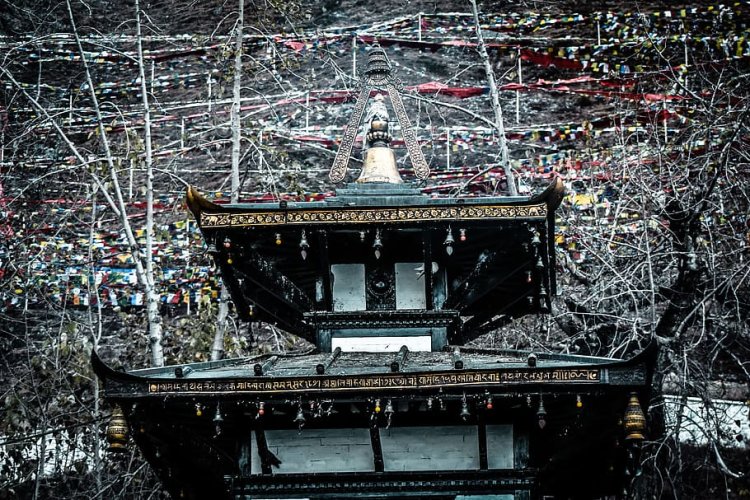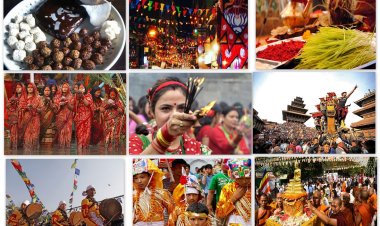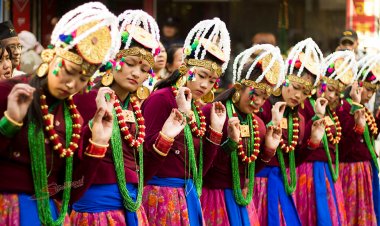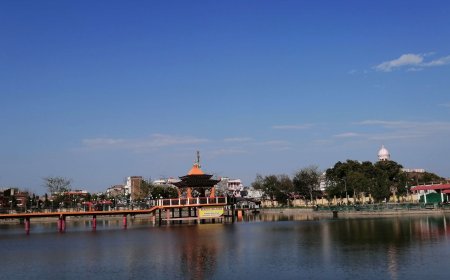Muktinath Temple: Nepal's Sacred Retreat in the Mustang District
Uncover the Sacred Secrets of Muktinath Temple: A Spiritual Pilgrimage in Nepal's Mustang District. Experience the serenity, rich history, and transformative essence of this revered destination surrounded by the breathtaking Himalayas.

Nestled in the breathtaking Mustang district of Nepal, Muktinath Temple stands as a revered spiritual destination for both Hindus and Buddhists. Located at an altitude of 3,710 meters (12,172 feet), this sacred temple holds immense significance and attracts pilgrims from around the world. With its rich history, religious importance, and serene ambiance, Muktinath Temple continues to captivate the hearts and souls of devotees.
Historical Significance:
Origins:
Muktinath Temple's origins can be traced back to ancient times According to Hindu mythology, the temple was established by the sage Shaligram, who enshrined a deity of Lord Vishnu within its sacred walls. It is believed to be one of the 108 Divya Desams, the holiest shrines dedicated to Lord Vishnu.
Hindu and Buddhist Connections:
Over the centuries, Muktinath Temple has evolved into a place of significance for both Hindus and Buddhists. The presence of a shrine dedicated to Chenrezig (Avalokiteshvara) in the temple complex adds a unique dimension, making it a harmonious blend of Hindu and Buddhist traditions.
Evolution over the centuries:
The temple's architecture and structure have undergone changes and renovations throughout history. Its cultural and spiritual significance has only grown with time, attracting pilgrims and travelers seeking solace and spiritual enlightenment.
Architectural Beauty:
Unique Temple Complex:
Muktinath Temple's architecture is a testament to the region's rich cultural heritage. The main temple features a distinctive pagoda-style design adorned with intricate woodwork and carvings. The temple complex comprises various other structures, including monasteries and shrines, showcasing a blend of traditional Nepali and Tibetan architectural styles.
Pagoda-style Architecture:
The pagoda-style architecture of Muktinath Temple is characterized by its multi-tiered roof, gracefully tapering upwards. This style is commonly seen in many Hindu and Buddhist temples across Nepal and reflects the region's religious and artistic traditions.
Symbolism in Design:
The architectural elements of Muktinath Temple hold symbolic significance. Intricate carvings depict mythological figures, celestial beings, and spiritual motifs, reflecting the temple's divine connection and inspiring a sense of awe and reverence among visitors.
Sacred Waters and Rituals:
The Mystical 108 Waterspouts:
One of the most remarkable features of Muktinath Temple is the presence of 108 waterspouts or "Muktidhara." These waterspouts are believed to originate from the sacred Gandaki River and represent the 108 sacred glasses of water of various holy rivers in India. Pilgrims often take ritual baths under these waterspouts, considering it a purifying experience for the body and soul.
Ritual Baths and Spiritual Cleansing:
The act of taking a ritual bath in the waters of Muktinath holds immense significance. It is believed to cleanse devotees of their sins, provide spiritual purification, and pave the way for spiritual liberation. Pilgrims immerse themselves in the sacred waters, seeking blessings and renewal of faith.
Connection to Hindu and Buddhist Beliefs:
The ritual of bathing in the sacred waters of Muktinath Temple is deeply rooted in both Hindu and Buddhist traditions. It represents the idea of washing away impurities, purifying one's soul, and attaining spiritual purity. This shared practice reinforces the unity and interfaith harmony at the temple.
Spiritual Liberation and Faith
Seeking Moksha at Muktinath Temple:
Muktinath Temple holds great significance for those seeking liberation from the cycle of birth and death. Devotees believe that by visiting the temple and performing religious rituals, they can attain "Moksha" or spiritual liberation. It is a place where they can connect with the divine and transcend worldly attachments.
The Role of Devotion and Faith:
Faith and devotion play a central role in the pilgrim's journey to Muktinath Temple. The arduous trek, the challenging terrain, and the altitude require determination and unwavering faith. Devotees embark on this spiritual pilgrimage with the belief that their prayers will be answered and their spiritual journey enriched.
Pilgrim Experiences and Testimonials:
Countless pilgrims have shared their transformative experiences at Muktinath Temple. They speak of a deep sense of peace, profound spiritual encounters, and a renewed connection with their inner selves. The temple's serene ambiance and the collective energy of devotion create an atmosphere conducive to introspection and self-discovery.
Festivals and Celebrations
Muktinath Jatra:
The Muktinath Jatra is an annual festival celebrated with great enthusiasm at the temple. Pilgrims from various parts of Nepal and beyond gather to participate in vibrant processions, religious ceremonies, and cultural performances. The festival is a celebration of faith, devotion, and community spirit.
Janai Purnima:
Janai Purnima is another significant festival observed at Muktinath Temple. Also known as Raksha Bandhan, this festival celebrates the bond between brothers and sisters. Devotees tie sacred threads (Janai) around their wrists and seek blessings from the divine, fostering love, and harmony among family members and communities.
Vibrant Cultural Gatherings:
Throughout the year, Muktinath Temple becomes a melting pot of diverse cultures and traditions. Pilgrims from different backgrounds come together to offer prayers, perform rituals, and share their cultural heritage. This vibrant convergence of people creates an atmosphere of unity, respect, and cultural exchange.
The Natural Beauty of Mustang
Enchanting Himalayan Scenery:
Muktinath Temple is situated in the captivating Mustang district, which is known for its awe-inspiring natural beauty. Surrounded by the mighty Himalayas, the temple offers panoramic views of snow-capped peaks, lush valleys, and cascading waterfalls. The mesmerizing landscape adds to the spiritual allure of the temple.
Trekking and Adventure Opportunities:
For adventure enthusiasts, Muktinath Temple serves as a gateway to various trekking routes and trails. The region offers exhilarating options like the Annapurna Circuit and the Thorong La Pass trek. Trekking through the picturesque Mustang region provides an opportunity to immerse oneself in the pristine wilderness and experience the rugged charm of the Himalayas.
Mustang's Unique Landscape:
Mustang is known for its arid desert-like terrain, contrasting the surrounding green valleys and forests. The region's unique geological formations, red cliffs, and cave dwellings add a sense of mystique and fascination. Exploring the rugged landscape of Mustang is an adventure in itself, offering glimpses into an ancient and untouched world.
Accessibility and Accommodation
Reaching Muktinath Temple:
Muktinath Temple can be reached by various means. The journey typically begins with a flight to Pokhara, followed by a drive to Jomsom. From Jomsom, a trek or a local mode of transportation takes pilgrims to the temple. It is advisable to plan the trip during favorable weather conditions and seek guidance from experienced trekking agencies.
Travel Tips and Precautions:
Visiting Muktinath Temple requires careful preparation and adherence to certain precautions. The high altitude demands acclimatization, and it is essential to carry proper trekking gear, clothing, and medication. It is advisable to consult with a medical professional before embarking on the journey.
Accommodation Options:
There are accommodation options available in the nearby villages of Ranipauwa and Jharkot. Guesthouses, lodges, and hotels provide pilgrims and travelers with comfortable resting places after a long day's journey. These accommodations offer basic amenities and a glimpse into the local culture and hospitality.
The Spiritual Essence of Muktinath
The Transformative Experience:
Visiting Muktinath Temple is more than just a physical journey; it is a transformative experience that touches the deepest realms of one's being. The temple's serene ambiance, sacred rituals, and the collective energy of devotion create an atmosphere where pilgrims can introspect, connect with their inner selves, and seek spiritual nourishment.
Serenity and Tranquillity:
Muktinath Temple's tranquil surroundings and the majestic Himalayan backdrop provide a serene environment for contemplation and meditation. Away from the chaos of urban life, the temple offers a peaceful retreat where one can find solace, practice mindfulness, and reconnect with nature.
A Place of Reflection and Renewal:
For many visitors, Muktinath Temple serves as a place of reflection and renewal. It offers a break from the routine of everyday life, allowing individuals to pause, introspect, and realign their priorities. The temple's spiritual essence inspires a sense of gratitude, compassion, and a renewed commitment to personal growth.
Muktinath Temple, nestled in the breathtaking Mustang district of Nepal, holds a special place in the hearts of pilgrims worldwide. Its rich history, cultural significance, and spiritual ambiance make it a revered destination for those seeking solace, spiritual liberation, and a deep connection with the divine. Muktinath Temple continues to captivate and inspire visitors from all walks of life, leaving an indelible mark on their spiritual journey. Whether seeking spiritual enlightenment or embarking on an adventure, Muktinath Temple offers a profound experience that leaves a lasting impression on the hearts and minds of all who visit.
Frequently Asked Questions:
-
How can I reach Muktinath Temple?
To reach Muktinath Temple, you can take a flight to Pokhara and then proceed to Jomsom by road. From Jomsom, you can either trek or use local transportation to reach the temple. -
What is the significance of the 108 waterspouts at Muktinath Temple?
The 108 waterspouts at Muktinath Temple represent the 108 sacred glasses of water from various holy rivers in India. Pilgrims take ritual baths under these waterspouts, believing it purifies the body and soul. -
Can non-Hindus and non-Buddhists visit Muktinath Temple?
Yes, Muktinath Temple welcomes visitors from all faiths and backgrounds. The temple promotes interfaith harmony and offers a spiritual experience to people of diverse beliefs. -
Are there accommodation options near Muktinath Temple?
Yes, there are accommodation options available in the nearby villages of Ranipauwa and Jharkot. Guesthouses, lodges, and hotels provide comfortable resting places for pilgrims and travelers. -
What makes Muktinath Temple a unique pilgrimage site?
Muktinath Temple stands out as a unique pilgrimage site due to its amalgamation of Hindu and Buddhist traditions, stunning Himalayan surroundings, and the transformative spiritual experiences it offers to visitors. -
What is the best time to visit Muktinath Temple?
The ideal time to visit Muktinath Temple is from April to June and September to November when the weather is pleasant and favorable for travel.
What's Your Reaction?





































































































